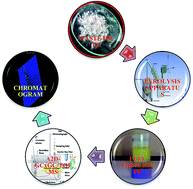Waste high-density poly(ethylene) (HD-PE) plastic deformation into liquid hydrocarbon fuel using a pyrolysis-catalytic cracking process with a copper carbonate (CuCO3) catalyst, at a temperature range from 23 °C to 390 °C. The pyrolysis-catalytic deformation process will help in environmental purification. The liquid hydrocarbons collected for use as a fuel were analyzed using Fourier-transform infrared spectroscopy (FT-IR), nuclear magnetic resonance (NMR), thermogravimetric analysis (TGA), two-dimensional gas chromatography/time of flight mass spectrometry (2D-GCxGC/TOFMS), inductively coupled plasma (ICP) analysis, and carbon, hydrogen, nitrogen, sulfur, and oxygen (CHNS/O) elemental analysis. The 2D-GCxGC/TOFMS results showed that various types of hydrocarbon compounds (aliphatics, aromatics, cyclics olefins, and phenanthrene) were available in the liquid hydrocarbon fuel. The conversion rates in four experiments which converted waste HD-PE plastic into liquid hydrocarbons for use as fuel were 85%, 90%, 94%, 92%, light gases 14.67%, 9.66%, 5.64%, 7.45% and residues 0.33%, 034%, 0.36%, 0.55%. Liquid hydrocarbons as fuel were found to be appropriate for use in petrol and diesel engines and they were found to be a good source of organic compounds/petrochemicals.

